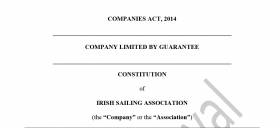Displaying items by tag: ISA
ISA Try Sailing Programme 2016
ISA President, David Lovegrove on an enhanced get started initiative
Spring is traditionally the time when most sailors’ dreams turn with eager anticipation to the approaching season. However, the Irish Sailing Association (ISA) has used the dormant months to plan and prepare for the forthcoming season. Shortly we will be launching a number of exciting new initiatives which we hope will help increase participation and also improve the skills of existing sailors.
Following on the success of the pilot programme in 2015, the 2016 Try Sailing programme will see a greatly enhanced package of assistance available. This will include: a Try Sailing Bursary, the Schools Try Sailing Initiative for Primary and Secondary Schools as part of Active School Week, the Corporate Cup Training Programme for new sailors to try Keelboat and Cruiser racing, the Round Ireland Trophy, Volvo Cork Week Try Sailing Invitational Cup and the Scouting Ireland Try Sailing Programme. There will also be Sailability Programmes catering for those Clubs who specifically want to facilitate people with disabilities to enjoy sailing and Family Fun initiatives to encourage club members to bring their family along and try the full extent of what the Club has to offer. The Try Sailing Programme is supported by the ISA’s dedicated Try Sailing website and PR Toolkit and by the Regional Development Officers team who will be on hand to help each Club develop their own Participation Programme.
On the Training side, the new simplified Small Boat Sailing Scheme (SBSS) syllabus and Advanced Instructor Endorsement will be introduced for the 2016 season in conjunction with the electronic logbook and Sailing Passport. These changes are in response to the feedback to put more focus on the development of skills and the logging of time on the water than on the acquiring of certificates. The SBSS will now focus on introducing sailors to the sport, their acquisition of basic skills and encouraging them to experience a broad range of sailing activities. The higher level racing aspects will from now on form part of a new Coaching Programme aimed specifically at those who wish to progress further into competition.
The new Coaching Programme will help existing sailors improve their skills so as to get more enjoyment from their participation in racing. The scheme will be based around Clubs and Classes with the objectives of providing them with a framework to provide a high standard of affordable coaching for their members, the creation of training structures to develop the pool of suitable coaches and the provision of course materials, aids and mentoring to assist this pool of qualified coaches. The objective of this is to help those sailors at club or class level who are not part of the ISA Performance activities.
We will be assisting Classes and Clubs with the introduction of the programme and running a number of pilot projects during the season and look forward to hearing from Classes and Clubs wishing to be involved.
This time of year is also the time of conferences. The Cruising conference was held in Howth Yacht Club on 20 February and was a sell-out success. We were fortunate in having some top class speakers who delivered excellent presentations. The main priority for the representation policy group is the ongoing issue which is causing frustration to many cruising sailors, and that is the current lack of a statutory registration system for small craft. The ISA will continue to lobby hard to try and speed up the process to establish the registration system for pleasure craft. Other areas being addressed include the passenger boat regulations which continue to restrict the activities of our cruising schools. The tax on green diesel and the foreshore licensing issues are also on the policy group's agenda.
The race officials held their conference on 28 February. It was an interesting event with Anthony O’Leary giving the “view from the tiller”. This is always a fascinating session as it gives race officials first–hand feedback of what sailors are looking for in race management.
The new website, which is focused on how the ISA can assist clubs and classes in improving their range of services to their members, is divided into four sections, which reflect the main thrust of ISA activities under the Strategic Plan. The four areas are: Try Sailing, Racing, Cruising and Training. The site will undergo further development in the coming months.
So with all this activity taking place, it only remains for me to wish you well in your preparations for the new season and hope that we all have fair weather.
Inaugural Cruising Conference At Howth
The inaugural ISA Cruising Conference at Howth Yacht Club attracted 90 sailors for a very informative day last Saturday.
ISA President David Lovegrove opened proceedings and Keynote speaker Eddie Nicholson and his crew entertained with an excellent show on their adventures to Greenland, with stunning photography, video footage and some eye opening tales of ice movement and local culinary delights. Simon Berrow, of Irish Whale and Dolphin Group and Galway / Mayo Institute of Technology, shared his knowledge of the biodiversity of whales and mammals along our Irish Coastline and gave advise on how leisure boat should approach them and help to ensure their safety.
Sponsorship from Union Chandlery and support from Cruising Association of Ireland helped to made the day a great success, along with the contributions and support from Nicky’s Place on Howth Pier, ICC Publications, Wild Atlantic Way, Met Eireann, INFOMAR, DTTAS, RNLI, Helly Hansen, IWDG, Cool Route & Howth Yacht Club all combined to give every delegate a bag full of fun goodies and useful information.
Experienced offshore sailor and author, Daria Blackwell, made a number of male skippers stop and think, with a talk on Women at the Helm. Many women take on the role of crew on board and never actually helm or rather I should say, skipper. The question that had many male skippers thinking was “If you fell overboard, would your crew be able action a safe ‘man over board?”. Not to mention how much easier it is helm a yacht in to a marina than to be the one jumping off with a line in one hand and a fender in the other. Norman Kean, Fellow of the Royal Institute of Navigation and ICC Publications Editor, gave an excellent explanation of the difference between Vector and Raster Electronic Charts, that left the audience assured that maintaining their knowledge of paper pencil navigation alongside their electronic navigation is always a good idea.
Clifford Brown of the Cruising Association of Ireland brought the room up to date with CAI’s “Crew Together” programme, where the East, West and South coast sailors match crew with boats and give sailors a chance to cruise in each others’ waters. Round the world sailor, Pat Murphy, entertained everyone with his tips on caring for, training and communicating with crew for cruising. In the ethos of the ISA programme of Try Sailing, cruising sailors were encouraged to welcome new crew on board and give them a chance to ‘Try Crewing’.
Vera Quinlan of the INFOMAR project at the Marine Institute, and experienced skipper, had everyone amazed by the detailed information available on the sea bed and the idea of being able to know just where your anchor is landing and what you are sailing over. She had everyone eager to learn more. The final talk on weather could have lasted all day as we all know how important forecasting is for sailing, especially in Irish waters. Willemien Phelan of Met Eireann and Volvo Ocean Race participant, gave a fantastic explanation of weather forecasting with John Leahy, Yachtmaster instructor and pilot.
Yacht Handicap Fees Increase for 2016
Yacht handicapping fees will rise by 12.5% for the coming season.
An average sized boat, such as a Sigma 33, will now have total handicapping costs of €177 in 2016 as opposed to €162 in 2015. This breaksdown as follows: ECHO registration is €42. IRC online registration is €13.50 per metre, an increase of €1.50 per metre (12.5%)
The Irish Sailing Association (ISA) is the administrator for both the local ECHO and international IRC handicap systems. IRC certs are processed for the ISA by the London based Royal Ocean Racing Club (RORC) who govern the IRC rule.
The ISA's CEO Harry Hermon says IRC fees are set in € for Irish boats at the beginning of each year. 'The IRC fee structure sent out with the renewals in January 2016 and showed a 12% increase which is due to the sterling exchange rates. There are no changes to the ECHO fees for 2016. Handicap fees will not be reviewed again until 2017'
Ireland has a national cruiser racer fleet estimated between 500–700 boats.
Meanwhile, handicaps will be a focus at the 2016 ICRA conference when it gets underway at the Castletroy Hotel in Lmerick on Saturday, March 5th.
The pow–wow will receive a presentation from the promoters of the ORC handicapping system that is gaining popularity as an alternative to IRC. Florida's recent Key West Regatta in Florida was split between the two systems.
Speaking to the Irish Times last Friday, former ICRA commodore Norbert Reilly said: “We have no idea what ORC is but would like to know and especially why it is making so much progress overseas.
ICRA also plan a review of the ECHO system for 2016.
Irish Cruising Comes Centre Stage In Howth Yacht Club
With last night’s Irish Cruising Club Annual General Meeting & Prize-Giving hosted at Howth Yacht Club, and this morning’s day-long ISA Cruising Conference at the same venue, centre stage has been taken by the silent majority – the large but distinctly reticent segment of the sailing population which emphatically does not have racing as its primary interest afloat. W M Nixon takes us on a guided tour.
The great Leif Eriksson would approve of some of the more adventurous members of the Irish Cruising Club. They seem to be obsessed with sailing to Greenland and cruising along its coast. And it was the doughty Viking’s father Erik Thorvaldsson (aka Erik the Red) who first told his fellow Icelanders that he’d given the name of Greenland to the enormous island he’d discovered far to the west of Iceland. He did so because he claimed much of it was so lush and fertile, with huge potential for rural and coastal development, that no other name would do.
Leif then followed in the family tradition of going completely over the top in naming newly-discovered real estate. He went even further west and discovered a foggy cold part of the American mainland which he promptly named Vinland, as he claimed the area was just one potential classic wine chateau after another, and hadn’t he brought back the vines to prove it?
In time, Erik’s enthusiasm for Greenland was seen as an early property scam. For no sooner had the Icelanders established a little settlement there around 1000 AD than a period of Arctic cooling began to set in, and by the mid-1300s there’d been a serious deterioration of the climate. What had been a Scandinavian population of maybe five thousands at its peak faded away, and gradually the Inuit people – originally from the American mainland – moved south from their first beachheads established to the northwest around 1200 AD. They proved more successful at adapting to what had become a Little Ice Age, while no Vikings were left.
Now we’re in the era of global warming, and there’s no doubt that Greenland is more accessible. But for those of us who think that cruising should be a matter of making yourself as comfortable as possible while your boats sails briskly across the sea in a temperate climate or perhaps even warmer for preference, the notion of devoting a summer to sailing to Greenland and taking on the challenge of its rugged iron coast, with ice everywhere, still takes a bit of getting used to.
Yet in recent years the Irish boats seem to have been tripping over each other up there. And for some true aficionados, the lure of the icy regions was in place long before the effects of global warming were visibly making it more accessible.
Peter Killen of Malahide, Commodore of the Irish Cruising Club, is a flag officer who leads by example. It was all of twenty years ago that he was first in Greenland with his Sigma 36 Black Pepper, and truly there was a lot of ice about. The weather was also dreadful, while Ireland was enjoying the best summer in years.

Peter Killen’s Sigma 36 Black Pepper in local ice at the quay inside Cape Farewell in Greenland, August 1995

ICC Commodore Peter Killen’s current boat is Pure Magic, an Amel Super Maramu seen here providing the backdrop for a fine penguin in Antarctica, December 2004.
More recently, he and his crew of longterm shipmates have been covering thousands of sea miles in the Amel Super Maramu 54 Pure Magic, among other ventures having a look at lots more ice down Antarctic way to see how it compares with the Arctic. With all their wanderings, by the end of the 2014 season Pure Magic was laid up for the winter in eastern Canada in Nova Scotia. So of course in order to get back to Ireland through 2015, the only way was with a long diversion up the west coast of Greenland. And the weather was grand, while Ireland definitely wasn’t enjoying the best summer in years.
The Pure Magic team certainly believe in enjoying their cruising, however rugged the terrain. If the Greenland Tourist Board are looking for a marketing manager, they could do no better than sign up the skipper of Pure Magic for the job. His entertaining log about cruising the region – featured in the usual impressive ICC Annual edited for the fourth time by Ed Wheeler – makes West Greenland seem a fun place with heaps of hospitality and friendly folk from one end to the other.

If ice is your thing, then this is the place to be – Peter Killen’s Pure Magic off the west Greenland coast, summer 2015.
But then Peter Killen is not as other men. I don’t mean he is some sort of alien being from the planet Zog. Or at least he isn’t so far as I know. But the fact is, he just doesn’t seem to feel the cold. I sailed with him on a raw Autumn day some years ago, and while the rest of us were piling on the layers, our skipper was as happy as Larry in a short-sleeved shirt.
I’d been thinking my memory had exaggerated this immunity to cold. But there sure enough in the latest ICC Annual is a photo of the crew of Pure Magic enjoying a visit to the little Katersugaasivik Museum in Nuuk, and the bould skipper is in what could well be the same skimpy outfit he was wearing when we sailed together all those years ago. As for the rest of the group, only tough nut Hugh Barry isn’t wearing a jacket of some sort – even Aqqala the Museum curator is wearing one.
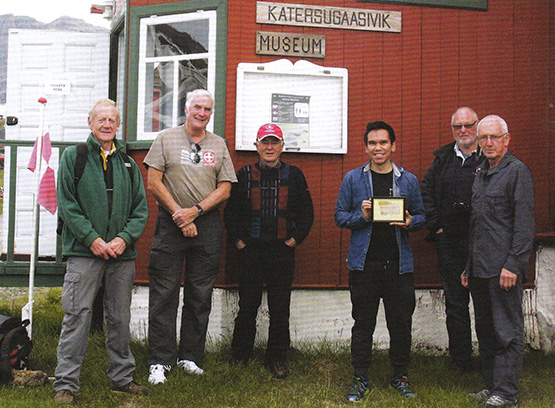
Some folk feel the cold more than others – Pure Magic’s crew absorbing local culture in Greenland are (left to right) Mike Alexander, Peter Killen, Hugh Barry, Aqqalu the museum curator, Robert Barker, and Joe Phelan
Having a skipper with this immunity to cold proved to be a Godsend before they left Greenland waters, when Pure Magic picked up a fishing net in her prop while motoring in a calm. Peter Killen has carried a wetsuit for emergencies for years, and finally it was used. He hauled it on, plunged in with breathing gear in action, and had the foul-up cleared in twenty minutes. Other skipper and Commodores please note……
The adjudicator for the 2015 logs was Hilary Keatinge, who has one of those choice-of-gender names which might confuse, so it’s good news to reveal that after 85 years, the ICC has had its first woman adjudicator. No better one for the job, man or woman. Before marrying the late Bill Keatinge, she was Hilary Roche, daughter of Terry Roche of Dun Laoghaire who cruised the entire coastline of Europe in a twenty year odyssey of successive summers, and his daughter has proven herself a formidable cruising person, a noted narrator of cruising experiences, and a successful writer of cruising guides and histories.
Nevertheless even she admitted last night that once all the material has arrived on the adjudicator’s screen, she finally appreciated the enormity of the task at hand, for the Irish Cruising Club just seems to go from strength to strength. Yet although it’s a club which limits itself to 550 members as anything beyond that would result in administrative overload and the lowering of standards, it ensures that the experience of its members benefit the entire sailing community through its regularly up-dated sailing directions for the entire coast of Ireland. And there’s overlap with the wider membership of the Cruising Association of Ireland, which will add extra talent to the expert lineup providing a host of information and guidance at today’s ISA Cruising Conference.
But that’s this morning’s work. Meanwhile last night’s dispensation of the silverware – some of which dates back to 1931 – revealed an extraordinarily active membership. And while they did have those hardy souls who ventured into icy regions, there were many others who went to places where the only ice within thousands of miles was in the nearest fridge, and instead of bare rocky mountains they cruised lush green coasts.
Nevertheless the ice men have it in terms of some of the top awards, as Hilary Keatinge has given the Atlantic Trophy for the best cruise with a passage of more than a thousand miles to the 4194 mile cruise of Peter Killen’s Pure Magic from Halifax to Nova Scotia to Howth, with those many diversions on the way, while the Strangford Cup for an alternative best cruise goes to Paddy Barry, who set forth from Poolbeg in the heart of Dublin Port, and by the time he’d returned he’d completed his “North Atlantic Crescent”, first to the Faeroes, then Iceland to port, then across the Denmark Strait to southeast Greenland for detailed cruising and mountaineering, then eventually towards Ireland but leaving Iceland to port, so they circumnavigated it in the midst of greater enterprises.
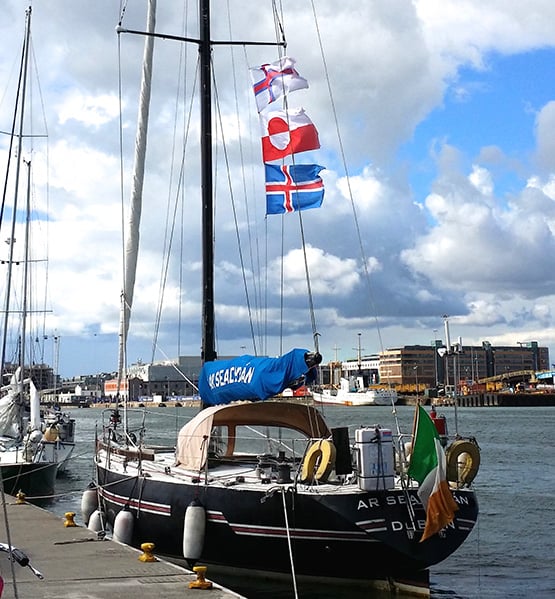
You collect very few courtesy ensigns in the frozen north. Back at Poolbeg in Dublin after her “North Atlantic Crescent” round Iceland and on to Greenland, Paddy Barry’s Ar Seachran sports the flags of the Faroes, Iceland and Greenland. Ar Seachran is a 1979 alloy-built Frers 45. Photo: Tony Brown
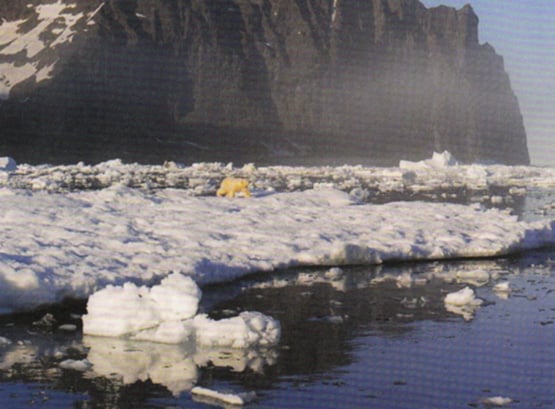
“Definitely the Arctic”. A polar bear spotted from Ar Seachran. Photo: Ronan O Caoimh
Paddy Barry started his epic ocean voyaging many years ago with the Galway Hooker St Patrick, but his cruising boat these days is very different, a classic Frers 45 offshore racer of 1979 vintage. Probably the last thing the Frers team were thinking when they turned out a whole range of these gorgeous performance boats thirty-five years ago was that their aluminium hulls would prove ideal for getting quickly to icy regions, and then coping with sea ice of all shapes and ices once they got there. But not only does Paddy Barry’s Ar Seacrhran do it with aplomb, so too does Jamie Young’s slightly larger sister, the Frers 49 Killary Flyer (ex Hesperia ex Noryema XI) from Connacht, whose later adventures in West Greenland featured recently in a TG4 documentary.
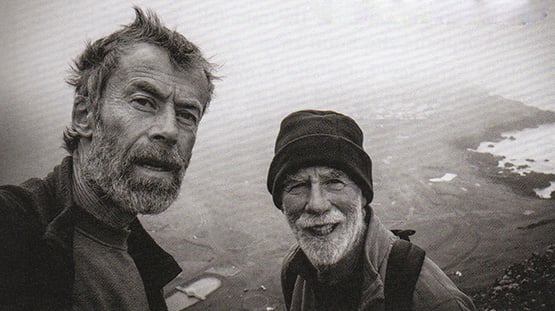
“A grand soft day in Iceland”. Harry Connolly and Paddy Barry setting out to take on mountains in Iceland during their award-winning cruise to Greenland. Photo: Harry Connolly
Pure Magic and Ar Seachran are hefty big boats, but the other ICC voyager rewarded last night by Hilary Keatinge for getting to Arctic waters did his cruise in the Lady Kate, a boat so ordinary you’d scarcely notice her were it not for the fact that she’s kept in exceptionally good trim.
Drive along in summer past the inner harbour at Dungarvan in West Waterford at low water, and you’ll inevitably be distracted by the number of locally-based bilge-keelers sitting serenely upright (more or less) on that famous Dungarvan mud. There amongst them might be the Moody 31 Lady Kate, for Dungarvan is her home port.
But she was away for quite a while last year, as Donal Walsh took her on an extraordinary cruise to the Arctic, going west of the British mainland then on via Orkney and Shetland to Norway whose coast goes on for ever until you reach the Artic Circle where the doughty Donal had a swim, as one does, and looked at a glacier or too, and then sailed home but this this time leaving the British mainland to starboard. A fabulous 3,500 mile eleven week cruise, he very deservedly was awarded the Fingal Cup for a venture the adjudicator reckons to be extra special – as she puts it, “you feel you’re part of the crew, though I don’t think I’d have done the Arctic Circle swim.”
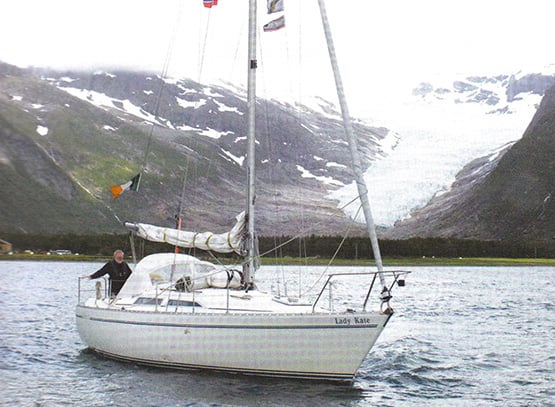
A long way from Dungarvan. Lady Kate with Donal Walsh off the Svartsen Glacier in northern Norway
Indeed, in taking an overview of the placings of the awards, you can reasonable conclude that the adjudicator reckons any civilized person can have enough of ice cruising, as she gives the ICC’s premier trophy, the Faulkner Cup, to a classic Atlantic triangle cruise to the Azores made from Dun Laoghaire by Alan Rountree with his van de Sadt-designed Legend 34 Tallulah, a boat of 1987 vintage which he completed himself (to a very high standard) from a hull made in Dublin by BJ Marine.
Tallulah looks as immaculate as ever, as we all saw at the Cruising Association of Ireland rally in Dublin’s River Liffey in September. And this is something of a special year for Alan Rountree, as completely independently of the Faulkner Cup award, the East Coast ICC members awarded their own area trophy, the Donegan Cup for longterm achievement, to Tallulah’s skipper. As one of those involved in the decision put it, basically he got the Donegan Trophy “for being Alan Rountree – what more can be said?”
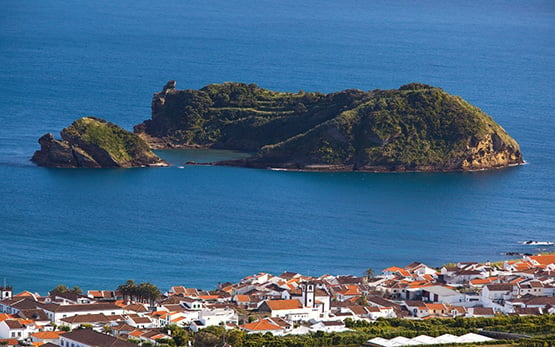
The essence of the Azores. Red roofs maybe, but not an iceberg in sight, and the green is even greener than Ireland. Alan Rountree’s succesful return cruise to the Azores has been awarded the ICC’s premier trophy, the Faulkner Cup.

Tallulah at the CAI Rally in the Liffey last Setpember. She looks as good today as when Alan Rountree completed her from a bare hull nearly thirty years ago. Photo: W M Nixon
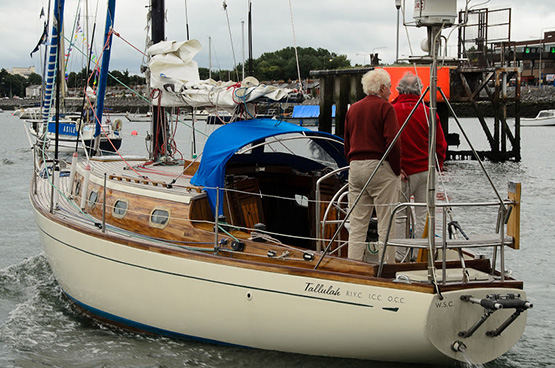
A boat to get you there – and back again. Tallulah takes her departure from the CAI Rally in Dublin. Photo: Aidan Coughlan
Well, it can be said that his Azores cruise was quietly courageous, for although the weather was fine in the islands, the nearer he got to Ireland the more unsettled it became, and he sailed with the recollection of Tallulah being rolled through 360 degrees as she crossed the Continental Shelf in a storm in 1991. But he simply plodded on through calm and storm, the job was done, and Tallulah is the latest recipient of a trophy which embodies the history of modern Irish cruising.
There were many other awards distributed last night, and for those who think that the ICC is all about enormous expensively-equipped boats, let it be recorded that the Marie Trophy for a best cruise in a boat under 30ft long went to Conor O’Byrne of Galway who sailed to the Hebrides with his Sadler 26 Calico Jack, while the Fortnight Cup was taken by a 32-footer, Harry Whelehan’s Jeanneau Sun Odyssey 32 for a fascinating cruise in detail round the Irish Sea, an area in which, the further east you get to coastlines known to very few Irish cruising men, then the bigger the tides become with very demanding challenges in the pilotage stales.
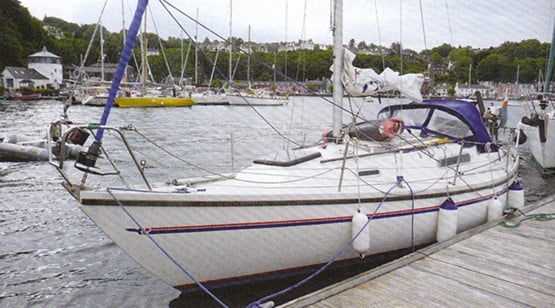
The smallest boat to be awarded a trophy at last night's Irish Cruising Club prize-giving was Conor O’Byrne’s Sadler 26 Calico Jack, seen here in Tobermory during her cruise from Connacht to the Hebrides
As for “expensively equipped”, the Rockabill Trophy for seamanship went to Paul Cooper, former Commodore of Clontarf Yacht & Boat Club and an ICC member for 32 years, who solved a series of very threatening problems with guts and ingenuity aboard someone else’s Spray replica during a 1500 mile voyage in the Caribbean, with very major problems being skillfully solved, as the judge observed, “without a cross word being spoken”.
Not surprisingly in view of the weather Ireland experienced for much of the season, there were no contenders for the Round Ireland cruise trophy, though I suppose you could argue that the return of Pure Magic meant the completion of a round Ireland venture, even if in this case the Emerald Isle becomes no more than a mark of the course.
In fact, with the unsettled weather conditions of recent summers in Ireland , there’s now quite a substantial group of ICC boats based out in Galicia in northwest Spain, where the mood of the coast and the weather “is like Ireland only better”. The ICC Annual gives us a glimpse of the activities of these exiles, and one of the most interesting photos in it is provided by Peter Haden of Ballyvaughan in County Clare, whose 36ft Westerly Seahawk Papageno has been based among the Galician rias for many years now.
Down there, the Irish cruising colony can even do a spot of racing provided it’s against interesting local tradtional boats, and Peter’s photo is of Dermod Lovett of Cork going flat out in his classic Salar 40 Lonehort against one of the local Dorna Xeiteras, which we’re told is the Galician equivalent of a Galway Bay gleoiteog. Whatever, neither boat in the photo is giving an inch.
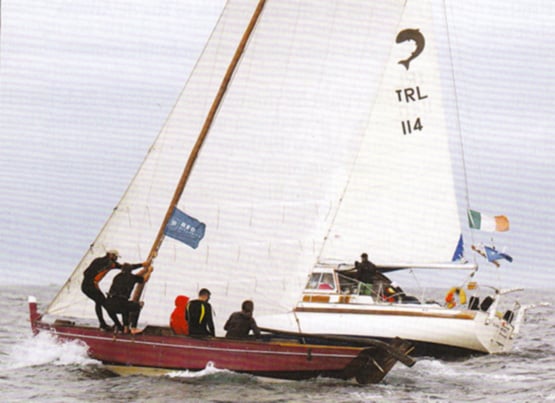
So who never races? Dermod Lovett ICC in competition with his Salar 40 Lonehort against a local traditional Dorna Xeiteira among the rias of northwest Spain. Photo: Peter Haden
Hilary Keatinge’s adjudication is a delight to read in itself, and last night after just about every sailing centre in Ireland was honoured with an ICC award for one of its locally-based members, naturally the crews leapt to the mainbrace and great was the splicing thereof.
But it’s back to porridge this morning in HYC and the serious work of the ISA Cruising Conference, where the range of topics is clearly of great interest, for the Conference was booked out within a very short time of being highlighted on the Afloat.ie website.
It’s during it that we’ll hear more about that intriguing little anchorage which provides our header photo, for although it could well be somewhere on the Algarve in Portugal, or even in the Ionian islands in Greece were it not for the evidence of tide, it is in fact on the Copper Coast of south Waterford, between Dungarvan and Dunmore East, and it’s known as Blind Harbour.
It’s a charming place if you’ve very settled weather, but it’s so small that you’d probably need to moor bow and stern if you were thinking to overnight, but that’s not really recommended anyway. Norman Kean, Editor of the Irish Cruising Club Sailing Directions, had heard about this intriguing little spot from Donal Walsh of Dungarvan (he who has just been awarded the Fingal Cup), and being Norman Kean, he and Geraldine just had to go and experience it for themselves. But it has taken three attempts to have the right conditions as they were sailing by, and it happened in 2015 in a very brief period of settled weather as they headed past in their recently-acquired Warrior 40 Coire Uisge, which has become the new flagship of the ICC’s informal survey flotilla.

The secret cove is to be found on Waterford’s Copper Coast, midway between Dungarvan and Dunmore East. Courtesy ICC
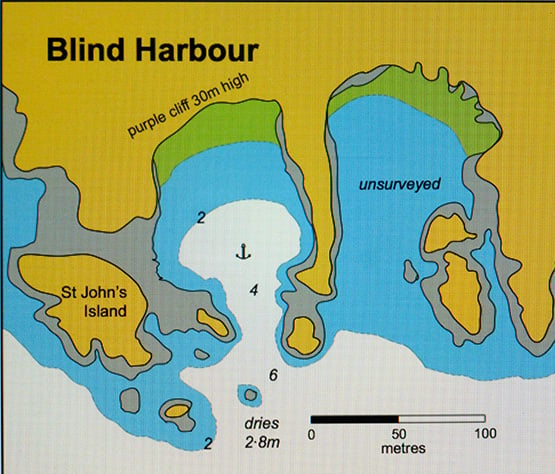
The newly-surveyed Blind Harbour on the Waterford coast as it appears in the latest edition of the ICC’s South & West Coasts Sailing Directions published this month. Courtesy ICC.
They found they’d to eye-ball their way in to this particular Blind Harbour (there are others so-named around the Irish coast) using the echo sounder, as any reliance on electronic chart assistance would have had them on the nearest part of County Waterford, albeit by only a matter of feet. With a similar exercise a couple of years ago, they found that the same thing was the case at the Joyce Sound Pass inside Slyne head in Connemara – rely in the chart plotter, and you’re making the pilotage into “impactive navigation”.
The message is that some parts of charts are still relying on surveys from a very long time ago, and locations of hyper-narrow channels may be a few metres away from where they actually are. On the other hand, electronic anomalies may arise. Whatever the reason, I know that a couple of years ago, in testing the ship’s gallant little chart plotter we headed for the tricky-enough Gillet passage inside the South Briggs at the south side of the entrance to Belfast Lough, and found that it indicated the rocks as shown were a tiny bit further north than we were seeing, which could have caused a but of a bump if we’d continued on our electronic way.
Electronic charts are only one of many topics which will be covered today. We hope to bring a full report next Saturday, for the participants will in turn require a day or two to digest their findings.
Proposed ISA Constitution To Go Before Members At AGM
#ISA - Irish Sailing Association members will be asked to approve the adoption of a revised ISA Constitution at the organisation's AGM at the Green Isle Hotel on Saturday 9 April.
The ISA says it has been working over the past year to bring its Constitution, Formerly the Memorandum & Articles of Association, up to date in accordance with the Companies Act 2014 as well as to reflect the new direction of the association and the needs of its membership.
The proposed ISA Constitution is available to read or download at the ISA website (the current Memorandum & Articles of Association are also available for comparison). A summary of changes will be published by the ISA next month ahead of the AGM.
'Sailing Passport' Heralds New Era For ISA's Training Programmes
#ISA - It's shaping up to be a year of big changes for trainees, tutors and coaches with the Irish Sailing Association as the organisation evolves to meet the demands of 21st–century sailing.
After taking on board feedback from the training review that formed part of last year's five-year strategic plan, 2016 will see a number of new initiatives introduced – and trainee sailors will be among the first to see the benefits.
These improvements include the simplification of the Small Boat Sailing Scheme, and changes to instructor endorsements to better differentiate between training for specific skills and holistic coaching, as well as putting greater focus on gaining skills and logging time on the water rather than trainees simply collecting certificates.
One of the biggest shifts internally in the association is the introduction of new technological solutions to reduce administration time and associated costs to training centres throughout Ireland.
And for the ISA's current crop of trainee sailors, the public face of that will be the new 'Sailing Passport' scheme.
Essentially an online, cloud-based logbook – accessible from computers, tablets and smartphones anywhere there's an internet connection – the Sailing Passport will replace existing paper-based methods of recording on-the-water activities and achievements.
Whether racing, cruising or just having fun, trainees will be able to record their sailing activities in a format that allows them and their instructors to easily track their progress in acquiring and developing the skills needed for any particular course or module.
Trainees in the Small Boat Sailing Scheme will be the first to benefit from this initiative before it's rolled out to power boating, windsurfing, cruising and other activities across the board.
Patrick Blaney has been leading the research and development of the Sailing Passport for the ISA and is co-ordinating its introduction in association with the association's Regional Development Officers.
As he explains, the passport is a response to the perception expressed in feedback to the ISA's Strategic Review Group that the association's training schemes were too focused on certification landmarks over individual sailors' development of skills.
"It's also part of the ISA development strategy to grow the levels of sailing activity outside of the traditional structured courses, particularly for young sailors," he says.
"The passport, as an online logbook, is designed to facilitate this by focussing on skills and experiences, not on certificates, and to do so in the 'modern' way – dispensing with paper logbooks that are easy to lose or damage, while also enabling training programmes be distributed to users more efficiently online."
Inspiration for the Sailing Passport comes from a similar system in use by Sail Canada for the last five years. That project was developed by former sailing instructors with digital and sports management knowhow, and has since been adopted by skiing chiefs and other sporting organisations in Canada.
The ISA's version is licensed from a sister programme called ChecKlick, and is already fully operational for the Small Boat Sailing Scheme, loaded with all the relevant Joe Soap Cards for skills development that student sailors will see checked off by their club or instructor as they progress, whenever or wherever they access their secure passport online.
But the system also allows individual sailors to add their own records for activities, goals and achievements as they track their training steps with greater accuracy, making for a more holistic approach to sail training over the previous 'gotta catch 'em all' collection of certificates.
The end result also serves as a kind of 'sailing CV', says Blaney, particularly useful for those working towards accreditation as a coach or instructor.
Trialing of the system has lead to some early positive feedback including this from Aengus Kennedy, principal of Rathmullan Sailing and Watersports School in Co Donegal:
"We started to use the ChecKlick system in 2015. The system is straightforward to use and the online tutorials work well as training manuals. Staff were up to speed quickly. Instructors have the opportunity to update each students progress throughout courses from their smartphones or devices which they embraced. Being able to print either certificates or a list of tasks achieved for each student at our leisure is a distinct advantage. Having a database of all students work and not paper logbooks is a big improvement."
The Sailing Passport will mean reduced costs for sailors and administrators alike, with access to the system costing €3 per participant.
With current paper log books costing €5 a pop, and certificates at €2 each, the savings will be significant over time, Blaney underlines.
Yet the costs are secondary to the vision of a more nimble, focused ISA that this project represents, something also reflected in the streamlining of the Small Boat Sailing Scheme itself.
That sees the revision of its upper-tier modules into a single level for each of three streams – Advanced Boat Handing; Start Racing; and Kites & Wires & Adventure – and the introduction of a new single Advanced Instructor Endorsement which will enable more and more clubs and training centres to acquire the resources necessary to offer the full suite of training modules.
What this all ultimately means for trainees is more choice and more flexibility in terms of where they can go to learn the skills they need, and what paths they can take to hone their preferences on the water, without being discouraged by the need for certification in skills that may block their advancement.
The coming year will reveal whether the ISA's first raft of changes will indeed encourage a brighter future for Ireland's young sailors.
A sailing passport briefing document prepared by the ISA is downloadable below.
The Irish Sailing Association has been awarded €323,000 just €100 less than 2015 in the annual payout from Sport Ireland, formerly known as the Irish Sports Council. Rowing Ireland was awarded 210,000.
Sport Ireland, the newly created agency for the development of sport in Ireland, announced a comprehensive package for sporting organisations in 2016. The announcement was made by Minister of State for Tourism and Sport, Michael Ring T.D. in Westport today.
To support Irish participation at the Rio Olympic and Paralympic Games in August and September, a total grant package in excess of €10 million was announced. In addition, with the supports of the services of the new Institute of Sport High Performance Training Centre, at Sport Ireland's National Sports Campus, the total investment in High Performance Sport for 2016 will be well in excess of €11 million.
In addition, there was a package of €10.6 million invested in National Governing Bodies of Sport with a further €5 million investment through the National Network of Local Sports Partnerships.
Speaking at the announcement, Minister Michael Ring said:
"I am pleased to announce this significant investment in Irish sport for 2016, through Sport Ireland's package of grants for the National Governing Bodies of Sport and the Local Sports Partnerships. The grants announced today will not only support the core activities of sports bodies, including their administration, they will also support very important sport programmes such as the Women in Sport and High Performance programmes, and the full range of services provided by Local Sport Partnerships around the country. I am delighted to have been able to increase Sport Ireland's budget by €3 million this year, which has enabled Sport Ireland to support High Performance sport in what is a very important year, with the Rio Olympic and Paralympic Games taking place. In addition, it is envisaged that significant funds will be available through Dormant Accounts Funding for sports programmes in disadvantaged communities to support the recently announced National Physical Activity Plan. The increase in funding for this year is a recognition of the Government's commitment and my own personal commitment to Sport".
Chair of Sport Ireland, Kieran Mulvey, speaking at the announcement added:
"We are delighted to announce a wide range of grants for Governing Bodies which cover the critical period of 2016 towards Rio but also a wide range of important programmes which are covered by the National Governing Bodies of Sport and the Local Sports Partnerships. Sport has flourished over the past number of years despite financial difficulties and have continued to expand their services. Some of the highlights of the today's announcement include:
- Over €1.8 million invested through the International Carding Scheme (Details of which will be announced soon)
- Additional investment has been allocated to the Olympic Council of Ireland to support the training camps and their Rio activities
- Significant investment has been allocated to Paralympics Ireland to support their pre-games camp in Uberlandia and all their games activities
- Additional support was to Hockey Ireland and Pentathlon Ireland who delivered outstanding results in 2015 and are well placed to deliver excellence in Rio
- Support will be provided to the IRFU towards the Olympic Repechage Rugby 7s taking place in UCD in June
- €200,000 will be invested through the Team Ireland Golf Trust to provide direct financial support to a number of golfers as well as additional financial support to hosting the Challenge Tour event in Ireland which is a vital component of the development of Irish Golf and Irish Golfers
- Over €600,000 will be invested in NGBs towards Women in Sport Programmes to ensure opportunities for women across the sporting spectrum (with further investment to be announced across the FAI and IRFU) and a further €114,700 through Local Sports Partnerships
John Treacy, Chief Executive of Sport Ireland explained:
"It's a really exciting time for Sport in Ireland. The establishment of the new agency has given Irish Sport a new home at Sport Ireland's National Sports Campus and with the additional resources made available to us this year we will drive on and continue to develop the Irish Sports sector. While 2016 will be a vital year in relation to Rio, we are also focused on our other obligations including our participation initiatives, supporting events at home and our anti doping programme. 2016 will be an exciting year and I would like to thank the Minister for his support through the last number of years".
Irish Sailor of the Year Awards Slideshow
Liam Shanahan was named the 2015 Afloat Irish Sailor of the Year at the Irish Sailing Awards in Dublin. Drawn from a star-studded shortlist, which included Volvo Ocean race winner Justin Slattery; round-Ireland record-setting Sidney Gavignet; and 11-time Paralympian John Twomey amongst others, Shanahan had a remarkable year, including victory in the Dun Laoghaire to Dingle race in June on his boat Ruth.
Kilkenny’s Doug Elmes and Malahide’s Colin O’Sullivan jointly took home the Irish Sailing Association (ISA) Youth Sailor of the Year award. The Howth Yacht Club sailors were hotly tipped following their recent Bronze medal success at the 2015 Youth World Championships in Malaysia, where they took Ireland’s first doublehanded youth worlds medal in 19 years. The shortlist for this tightly contested award included Tipperary’s Aisling Keller; Howth’s Aoife Hopkins and Ewan McMahon; and Waterford’s Geoff Power.
The Mitsubishi Motors Sailing Club of the Year award was presented to the Royal Irish Yacht Club in honour of their success at local, national and international level. The award also takes into account satisfaction of club members; the club's impact in sailing development and training; the relationship with the local community, and relevant governmental and sporting bodies, both at local and national level.
Mullingar Sailing Club took home the ISA Training Centre of the Year award, having been nominated as winners of the western-region Training Centre of the Year. Dun Laoghaire’s Royal Irish Yacht Club (eastern region winners), and Limerick’s Foynes Yacht Club (southern region winners) were also shortlisted.
#SailorOfTheYear – Liam Shanahan has been named Afloat.ie Irish Sailor of the Year for 2015.
The Irish Sea yachtsman and June's Sailor of the Month was presented his award by Sport Ireland chief executive John Treacy at the Irish Sailing Awards gala in Dublin's Royal College of Surgeons this afternoon (Thursday 4 February).
Liam Shanahan wins overall 2015 Sailor of the Year https://t.co/MDaTjreQZG pic.twitter.com/Mnz6aEy9qK
— Irish Times Sport (@IrishTimesSport) February 5, 2016
Shanahan was recognised for his comprehensive victory in the 280-mile Dun Laoghaire to Dingle Race at the helm of Ruth, his family's J/109, marking the highlight of a busy June in Irish sailing.
Not one to rest on his laurels, Shanahan – and his dependable crew, especially so since they're family – would go on to retain the James Eadie Trophy in the ISORA Offshore Championship, fending off the strong challenge of Andrew Hall's J/125 Jackknife and Peter Dunlop and Vicky Cox's J/109 Mojito in the season's final race from Pwllheli to Dun Laoghaire in September.
And what's more, Shanahan was the clear choice of both the judging panel and Afloat.ie readers alike from the field of 17 individual and joint nominees, garnering 1,359 votes out of nearly 6,500 cast.
In accepting his prize, Shanahan said it was "an award for Corinthian and family sailing", which he regards as the heart and future of the Irish sailing scene.
Hosted by entrepreneur Bobby Kerr along with Afloat.ie's WM Nixon and Irish Sailing Association (ISA) president David Lovegrove, the Irish Sailing Awards also recognised the ISA Youth Sailor of the Year and Training Centre of the Year, as well as the Mitsubishi Motors Club of the Year.
Guests at the event included members of the ISA's Olympic and youth sailing squads, national senior and youth champions, class captains and club commodores, and a number of past Sailor of the Year awardees, such as 2012's winner George Kenefick.
2015 Afloat Irish Sailor of the Year winner Liam Shanahan at the Irish Sailing Awards today: Dublin @AfloatMagazine pic.twitter.com/sExNo1b4uy
— Irish Sailing (@Irish_Sailing) February 4, 2016
Ireland’s Boats & People – How Do We Get Them Together?
The recently-published ISA Survey of Club Racing commissioned and supervised by Board Member Jack Roy has started the process of putting together a realistic picture of how we sail and go afloat for recreation, and it was analysed on publication here in Afloat.ie.
It’s logical to have made the beginning with club racing, as racing provides its own narrative and a straightforward set of entry numbers and results. But it will become more complex as the national authority tries to provide realistic figures for day sailing’s less competitive aspects. And of course, once we enter the world of cruising as defined by sailing and boating projects which include passage making, both coastal and offshore, together with overnight on-board stops, then it can become much more difficult to get meaningful data.
Yet with the ISA’s Cruising Conference for February 20th already booked out within a few days of being announced on Afloat.ie, clearly that is an area in search of services and support, a section of sailing which is difficult to quantify yet obviously of strong interest to a significant number of boat enthusiasts. W M Nixon takes a look at how the complexity of our sport’s many specialities makes it difficult to provide a clearcut picture for possible recruits to sailing.
Where would we be without the International Optimist Dinghy? The little solo-sailing boxes and their attendant support teams of mum and dad and the dog and the old 4X4 or station wagon or people carrier or whatever may seem to take up an awful lot of space and time, and all just so that one little person can go sailing.
But at least that one little person does go sailing. The ISA figures are brutally straightforward. In terms of genuine turnouts afloat at clubs throughout Ireland, in boat numbers the active Optimists are exceeded only by the Lasers, and this is arguably because Lasers aren’t age-limited, whereas the Optimists most definitely are.

Optimist airborne. This is Ireland's second most popular class
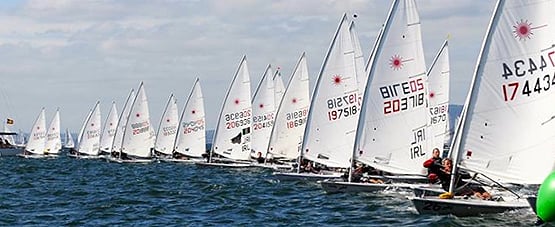
Ireland’s most popular dinghy class, the Laser is seen here at the Zhik Irish Nationals at Ballyholme
So we give a qualified cheer for the success of these two little boats. But it’s qualified because they’re single-handers which fail to provide any crew-relating sailing skills. Leading sailing figures as diverse as Des McWilliam of Crosshaven and Norman Lee of Greystones have been eloquent in promoting the notion that we should be doing more – much more – to encourage two-handed boats, and if we can persuade people into three-handed boats, well, so much the better.
Certainly that’s one of the reasons why our header photo says so much. A lone sailor in an Optimist or Laser promotes too much of a solitary, even an isolated image. And a two-handed boat like the GP 14, whose strong fleet figures in the ISA survey show the class’s vigour, is arguably just an act for a dynamic duo – it’s Strictly Come Dancing goes sailing…..
But getting three together to race a characterful boat like the National 18 with style – now that’s something special, that really is a superb combination of people skills interacting with sailing talent. And it’s a joy to behold. Yet anyone can see that for a complete beginner to sailing, this extraordinary silhouette of Tommy Dwyer’s National 18 against the November sky above the Hill of Howth will have an otherworldly air about it – “That’s not for me” is as likely a response as “Let’s have a go at that”.
Even those of us who have been in sailing for longer than we care to remember find the image decidedly thought-provoking, for we have some idea of what has been involved in creating the circumstances for this seemingly effortless balancing act, this lighter-than-air effect in the unlikely setting of a November afternoon.
Over the past year or so we have been recounting in Afloat,ie how the Cork Harbour National 18 Class, with very tangible backing from the Royal Cork Yacht Club, have been in the forefront of the development of the new ground-breaking Phil Morrison take on the long-established National 18, which is a developmental class which from time to time takes a leap in hull design, and moves forward in order to keep the spirit alive.
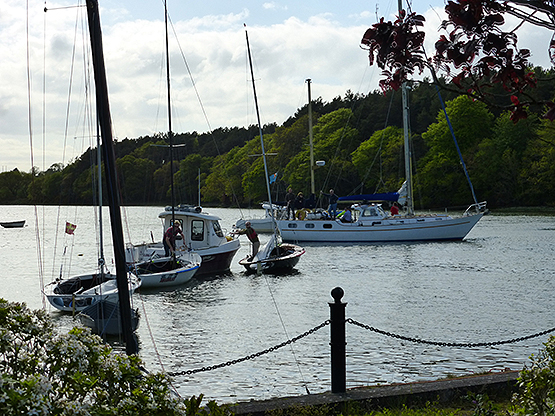
The National 18s are part of the fabric of Cork Harbour sailing. Before the new Morrison boats arrived in July, the old fleet were seen here in May 2015 after their annual race to Ballinacurra in northeast Cork Harbour in company with the Dwyer brothers’ cruising ketch. Photo: W M Nixon
Acceptance of this is something which seems to be bred into Cork’s National 18 enthusiasts, many of whom have the advantage of being firmly of the opinion that a proper dinghy needs three people to sail it. But the social matrix which has built up around Cork Harbour over many decades with this concept at its heart is not something which will necessarily travel easily to other areas, and although the six boats of the National 18 flotilla which visited Howth for the Open Day got a great reception and gave many people from other classes a marvellous time afloat, it’s probable that the very different mood around sailing in Dublin means that something so technically and socially challenging as a three man dinghy is a step too far.
Sailing in the greater Dublin area seems to exist within a framework of independent balloons. While there are those who will happily move from one boat type to another and cheerfully spread their talents and enjoyment about, by contrast there’s the Dublin Bay Sailing Club Thursday Evening Phenomenon.
Thursday is when the DBSC cruiser classes go out to race. And there’s an entire cohort of people, mostly folk who work in offices in the city, who on a Thursday evening go straight to Dun Laoghaire, get aboard a pontoon-based cruiser owned by someone else, go out and race in some very specific crewing job, then come back in and have supper in club or pub with their shipmates, and then that’s it until next Thursday. Just one evening each summer mid-week is their entire sailing programme. Weekends are for something else. And as for the hassle and mixed joys of boat ownership and maintenance, that’s not their department at all.
It’s a very metropolitan, very citified yet specialized way of doing things, and Dublin is one of the very few cities whose location facilitates it. It will be fascinating to measure it, for Dublin’s way of sailing is steeped in history and tradition. But for now it’s refreshing to look at a place which has had a sailing tradition in times past, but somehow lost it, yet it’s coming back again, and one of the good news stories towards the end of 2015 is that the new Youghal Sailing Club has been accepted into the ISA fold.
Youghal at present is a difficult place for sailing, as the tidal power of the mighty Munster Blackwater sweeps straight through the estuary and along the old town’s waterfront, and the creation of any meaningful modern facilities will have the immediate difficulty of silting by incredibly adhesive black mud.

With the sun out, and the tide in, Youghal looks to be an ideal location for the easy installation of a marina….....Photo: W M Nixon
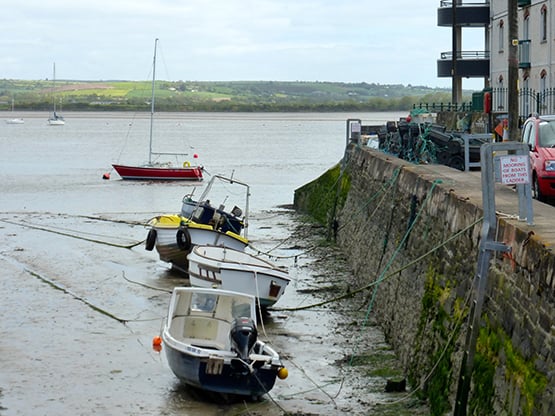
….but with the sun in and the tide out, the mud problem is revealed. Photo: W M Nixon
Thus, as dedicated Afloat.ie readers will have recently observed, no sooner had one group announced that a marina in Youghal was on the way than another longer-established group quietly suppressed the story, as they’re well aware of the engineering and dredging difficulties involved, and premature announcements will only slow any project in the long run.
In the fullness of time, a marina at Youghal will be a godsend for any cruiser plugging along the south coast. It’s not always the easiest coast in the world to make a passage along, sometimes it can seem an awfully long way to Cork from Dunmore East or Kilmore Quay even if you do make stopovers at Dungarvan or Helvick, and there are times when the hardiest seafarer is glad enough to get his boat secured to a good big pontoon.
But that’s for the future. Meantime, the locally-based keelboats are using either the restless anchorage off the town, or the more serene pool across the estuary at Ferry Point on the east shore, while the new club’s flotilla of GP 14s are stored in spare warehouse space during non-sailing time, and when they do go sailing it turns out their clubhouse is a moveable feast - it’s a caravan which can be towed to a choice of sailing locations.
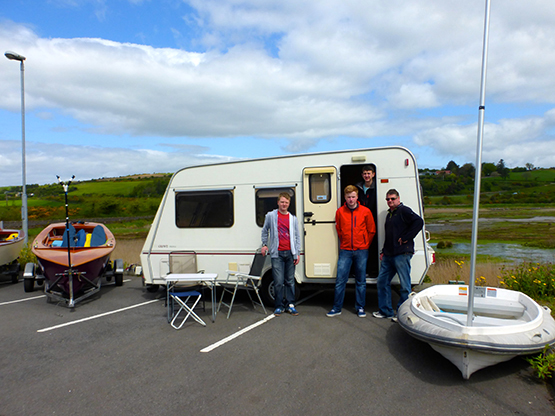
A moveable feast. Members of the newly-affiliated Youghal Sailing Club with their caravan HQ, Adrian Lee in doorway. Photo: W M Nixon
On the national stage, it is young Youghal GP 14 sailor Adrian Lee who has been among those flying the club’s flag, and there’s hope in the air. When we were there in May on a fine day that promised a summer which never arrived, we couldn’t help but think that when they do get their facilities and maybe even a clubhouse, they’ll look back to the days of the caravan and ad hoc racing arrangements with sweet nostalgia. For sometimes, it’s much better to be travelling than it is to arrive.
But for the rest of us, the message from Youghal is simple. The sea is for sailing. Use it or lose it. By all means get proper people surveys done which indicate the way numbers are shaping up and things are going. But really, if you want to persuade people to go sailing, the best way is by example, getting afloat as much as possible yourself. And maybe then you’ll find the time to welcome aboard newcomers too.

Reviving Youghal sailing – on race days, the club’s caravan is simply towed down to the pier and the races are started from there. Photo: W M Nixon
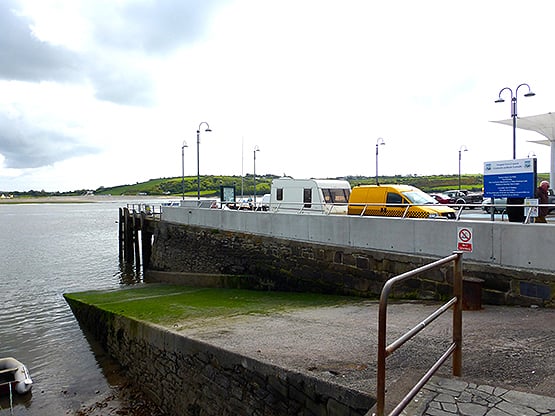
Youghal’s massive public slip provides launching for the YSC sailing dinghies, but during 2015 the boats had to be stored at the other end of town when not in use. Photo: W M Nixon
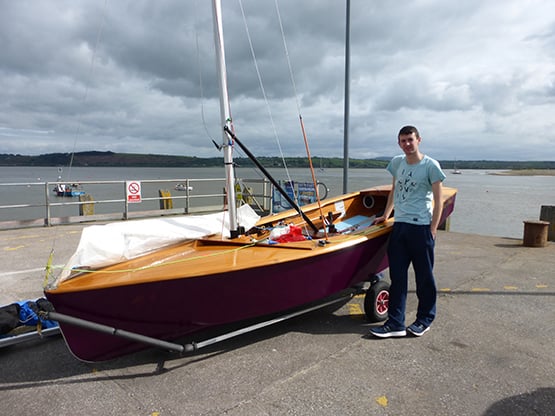
The pace-setter. Adrian Lee of Youghal SC with his Duffin-built GP14. Photo: W M Nixon
Click to download: ISA Survey of Club Racing





























